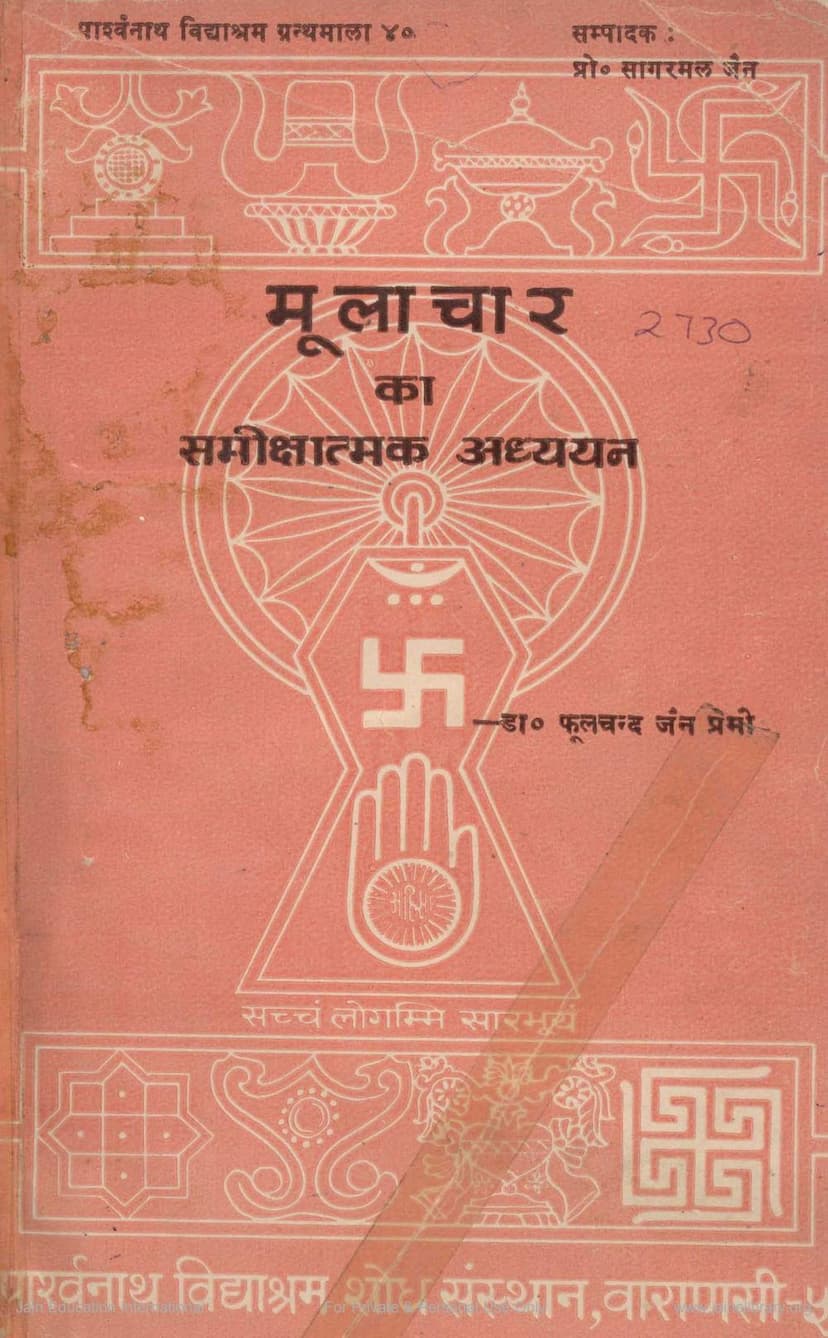Mulachar Ka Samikshatmak Adhyayana
Added to library: September 2, 2025

Summary
This is a comprehensive summary of "Mulachar ka Samikshatmak Adhyayana" by Fulchandra Jain Shastri, based on the provided text:
Book Title: Mulachar ka Samikshatmak Adhyayana (A Critical Study of the Mulācāra) Author: Dr. Phool Chand Jain Premi Publisher: Parshwanath Shodhpith, Varanasi Catalog Link: https://jainqq.org/explore/002088/1
Overview: "Mulachar ka Samikshatmak Adhyayana" is a scholarly work by Dr. Phool Chand Jain Premi, which was originally his doctoral dissertation submitted to Banaras Hindu University in 1977. The book is a revised and expanded version of his Ph.D. thesis, reflecting years of dedicated study and research on the foundational Jain text, Mulācāra. Mulācāra is considered a principal text in the Digambara tradition, outlining the code of conduct for Jain monks (Śramanas). Dr. Premi's study critically analyzes Mulācāra, comparing its contents with Śvetāmbara scriptures and other Indian religious traditions, making it a significant contribution to comparative and integrated studies in Jainism.
Key Aspects of the Study:
-
Mulācāra as a Foundational Text: The study highlights Mulācāra's importance as the primary treatise on monastic conduct (Śramaṇācāra) in the Digambara tradition. It is believed to be the concise and authoritative compilation of the original Ācārāṅga, containing 1252 Prakrit gāthās spread across twelve chapters. The text is praised for its detailed and systematic exposition of the monastic code of conduct, unparalleled in its comprehensiveness.
-
Author's Scholarly Approach: Dr. Phool Chand Jain Premi meticulously studied Mulācāra, utilizing authentic editions and ancient manuscripts. He adopted a comparative approach, drawing parallels and distinctions with Śvetāmbara canonical texts like Ācārāṅga, Daśavaikālika, Niśītha, Vyavahāra, Bṛhatkalpa, and various Niryuktis and Prākīrṇakas. He also incorporated comparative analysis with other Indian religious traditions, enriching the study'e scholarly depth. Dr. Premi emphasizes his commitment to academic rigor and intellectual honesty, striving to present facts objectively without sectarian bias.
-
Structure and Content: The book is divided into six chapters, each delving into specific aspects of Mulācāra and Jain philosophy:
- Chapter 1: Prastāvik (Introduction): This chapter provides an overview of Jain ascetic literature, introduces Mulācāra, discusses its commentary literature, details its gāthā count, and explores the relationship and similarities between Mulācāra and the works of Ācārya Kundakunda. It also addresses controversies regarding the authorship of Mulācāra, concluding that it is most likely authored by Ācārya Vattakera, predating Kundakunda.
- Chapter 2: Mūlaguṇa (Basic Conduct): This chapter focuses on the twenty-eight fundamental vows and practices prescribed for monks. It details the five great vows (Mahāvratas), five purities (Samitis), five restraints of the senses (Indriya Nirodha), six essential duties (Āvaśyakas), and seven other essential practices like Keśalocha (hair-plucking), Achilakya (nudity), etc. The study emphasizes that these Mūlaguṇas form the bedrock of monastic life.
- Chapter 3: Uttaraguṇa (Secondary Conduct): This section analyzes the secondary vows and practices that supplement the Mūlaguṇas. It covers subjects like Śīla (virtues), sixteen thousand types of virtues, eighty-four lakh virtues, Tapas (asceticism) with its internal and external divisions, twenty-two types of hardships (Pariṣaha), the five Ācāras (Darśanācāra, Jñānācāra, Cāritrācāra, Tapācāra, and Vīryācāra), ten virtues (Dharma), and twelve contemplation subjects (Anuprekshā).
- Chapter 4: Āhāra, Vihāra, and Vyavahāra (Diet, Conduct, and Social Interaction): This chapter meticulously details the prescribed conduct related to monastic diet (Āhāra), daily routines and travel (Vihāra), and social interactions (Vyavahāra). It covers rules for alms rounds, food purification, acceptable and prohibited foods, conduct during travel, staying in monastic dwellings (Vastikā), rules of conduct between monks and nuns, and interactions within the monastic community.
- Chapter 5: Śramaṇa Saṅgha (Monastic Community): This chapter discusses the structure and organization of the Jain monastic community. It elaborates on the roles of key figures like Ācārya, Upādhyāya, Pravartaka, Sthavira, and Gaṇadhara, and explores the concept of the fourfold community (Śramaṇa, Āryikā, Śrāvaka, Śrāvikā). It also delves into the specific conduct of Āryikās (nuns) and their relationship with monks.
- Chapter 6: Jain Siddhānta (Jain Principles): This chapter delves into core Jain philosophical principles discussed within Mulācāra. It covers the nature of the universe (Loka), the soul (Jīva), non-soul (Ajīva), the seven realities (Dravyas), the fourteen stages of spiritual progress (Guṇasthāna), the six states of existence (Leśyā), and the principles of karma, liberation (Moksha), etc.
-
Comparative Analysis: A significant aspect of Dr. Premi's study is its extensive comparison with other Jain sects (Śvetāmbara) and other Indian religious traditions. This comparative approach helps to understand the shared heritage and the evolution of practices within the broader Indian religious landscape. The study notes the presence of hundreds of identical Prakrit gāthās in both Śvetāmbara and Digambara canons, suggesting a common origin in the undivided Jaina tradition.
-
Authorship of Mulācāra: The study addresses the debate surrounding the authorship of Mulācāra, weighing the views that attribute it to Ācārya Kundakunda, a collection by various ācāryas, or its most likely author, Ācārya Vattakera. Based on linguistic analysis, comparative evidence from later texts, and the mentions of Vattakera by commentators like Vasunandi, Dr. Premi leans towards Vattakera as the primary author, possibly drawing from earlier traditions.
-
Praise and Recognition: The book has received commendations from esteemed scholars like Acharya Baldev Upadhyay and Siddhantacharya Pt. Jagannamonlal Shastri, who highlight its scholarly depth, comparative insights, and contribution to understanding Jain monasticism. The publication was supported by a generous grant from Sardar Malji Kankaria of Kolkata, in memory of his elder brother Parasmalji Kankaria, a respected layman known for his religious and social contributions.
Conclusion: "Mulachar ka Samikshatmak Adhyayana" is a monumental work that provides an in-depth, critical, and comprehensive understanding of Mulācāra and its significance within Jain monastic traditions. Dr. Phool Chand Jain Premi's rigorous research, meticulous analysis, and comparative approach make this book an indispensable resource for scholars, students, and anyone interested in the ethical and philosophical underpinnings of Jain monasticism. The book not only illuminates the specific teachings of Mulācāra but also places it within the broader context of Indian religious thought.